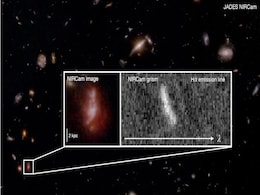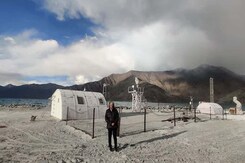Astrophysics
- All
- News
- Videos
-

NASA's IXPE Solves Long-Standing Mystery Behind Black Hole Jets
- Thursday December 18, 2025
- Science |
NASA's IXPE mission has identified how X-rays are produced in the jet of a supermassive black hole, confirming that they originate from the same jet through synchrotron self-Compton scattering and resolving a long-standing question in X-ray astronomy
-
 www.ndtv.com
www.ndtv.com
-

Astronomers Witness Longest-Lasting Gamma-Ray Burst in History, 8 Billion Light-Years Away
- Tuesday December 16, 2025
A gamma-ray burst lasting over seven hours was recorded 8 billion light-years away, revealing a rare type of cosmic explosion and challenging current astrophysics models.
-
 www.gadgets360.com
www.gadgets360.com
-

New Orbital Clues Reveal How Hot Jupiters Moved Close to Their Stars
- Tuesday December 16, 2025
Researchers reveal some hot Jupiters drifted inward smoothly through protoplanetary disks, offering clues to planetary system formation and stability.
-
 www.gadgets360.com
www.gadgets360.com
-

Chandra’s New X-Ray Mapping Exposes the Invisible Engines Powering Galaxy Clusters
- Friday December 12, 2025
NASA’s Chandra X-ray Observatory has released stunning colour-coded galaxy cluster images that reveal shock waves, cooling gas, and cavities carved by supermassive black holes. By separating X-ray light into different energy bands, astronomers can now visualise hidden cosmic processes that shape the universe’s largest structures and control how...
-
 www.gadgets360.com
www.gadgets360.com
-

Misaligned Exoplanet Is Challenging How We Think Solar Systems Form
- Friday December 5, 2025
Astronomers studying the dwarf-star system TOI-3884b have uncovered a striking anomaly: the planet’s orbit is sharply misaligned with its star’s rotation. Using multicolour transit observations, researchers detected repeated starspot-crossing events that revealed the planet passes over cooler regions on the stellar surface. Follow-up monitoring...
-
 www.gadgets360.com
www.gadgets360.com
-

Dark Matter May Have Been Seen for the First Time in NASA Gamma-Ray Data
- Wednesday November 26, 2025
A new analysis of NASA’s Fermi telescope data reveals a faint gamma-ray halo around the Milky Way’s core, matching predictions for annihilating dark-matter particles. Researchers say no known astrophysical source fits the signal, raising the possibility of the first direct evidence of dark matter. Experts, however, stress caution and call for v...
-
 www.gadgets360.com
www.gadgets360.com
-

Astronomers Uncover the Vast Greater Pleiades Complex with 3,000 Hidden Stars
- Monday November 17, 2025
Astronomers analyzing Gaia and TESS data have discovered that the famed Pleiades is only the bright center of a much larger stellar complex containing over 3,000 stars. Spanning 2,000 light-years, this vast family reveals how young clusters form, travel, and disperse across the galaxy.
-
 www.gadgets360.com
www.gadgets360.com
-

Scientists Recreate Cosmic ‘Fireballs’ in Lab to Solve Mystery of Missing Gamma Rays
- Wednesday November 5, 2025
Scientists recreated cosmic plasma beams at CERN to study why certain gamma rays vanish in space. The results showed the beams remain stable, suggesting ancient intergalactic magnetic fields, not beam collapse, hide the signals. The discovery provides new insight into cosmic jets and the universe’s earliest magnetic traces.
-
 www.gadgets360.com
www.gadgets360.com
-

Mystery Deepens as Interstellar Comet 3I/ATLAS Brightens Unexpectedly Near the Sun
- Thursday November 6, 2025
Interstellar comet 3I/ATLAS defied expectations during its 2025 solar flyby, brightening far faster than predicted. Observatories worldwide recorded a blue coma rich in exotic gases, suggesting unique chemistry from another star system. Scientists are investigating whether its unusual composition or speed caused the outburst, marking a new interste...
-
 www.gadgets360.com
www.gadgets360.com
-

Dark Matter May Behave Like Ordinary Matter Under Gravity, New Study Finds
- Tuesday November 4, 2025
A new study shows dark matter falls into cosmic gravity wells much like ordinary matter, narrowing one of astronomy’s biggest mysteries. Researchers say any unknown force acting on dark matter must be very weak, though future missions could detect smaller effects. The findings bring scientists closer to understanding how the universe’s unseen m...
-
 www.gadgets360.com
www.gadgets360.com
-

Keio University Team Measures Ancient Cosmic Temperature, Confirming Big Bang Prediction
- Tuesday November 4, 2025
Using ALMA, Keio University scientists measured a 5.13 K cosmic background temperature from 7 billion years ago—matching Big Bang predictions of universal cooling. This precise reading, based on quasar absorption data, is the most accurate at that epoch and offers strong confirmation of how the Universe’s temperature decreases over time.
-
 www.gadgets360.com
www.gadgets360.com
-

LIGO Detect Possible Second-Generation Black Holes with Extreme Spins
- Sunday November 2, 2025
LIGO-Virgo-KAGRA observatories detected two extraordinary black hole collisions in late 2024—GW241011 and GW241110. The first involved a rapidly spinning black hole, while the second revealed one rotating opposite its orbit. These findings fit predictions for second-generation black holes, born from earlier mergers within crowded star clusters. T...
-
 www.gadgets360.com
www.gadgets360.com
-

James Webb Telescope Finds Early Universe Galaxies Were More Chaotic Than We Thought
- Thursday October 23, 2025
The James Webb Space Telescope has revealed that galaxies in the early universe were far more chaotic and unstable than once believed. A new study shows that gas turbulence and intense star formation disrupted young galaxies, reshaping scientists’ understanding of how galaxies evolved into the structured systems seen today.
-
 www.gadgets360.com
www.gadgets360.com
-

DU Recruitment 2025: Professor, Associate Professor Application Window Closes Soon, Apply Here
- Thursday October 16, 2025
- Education |
DU Professor Recruitment 2025: Candidates can apply to work as Professor and Associate Professor under three departments - Management Studies, Physics and Astrophysics and Social work.
-
 www.ndtv.com/education
www.ndtv.com/education
-

NASA's IXPE Solves Long-Standing Mystery Behind Black Hole Jets
- Thursday December 18, 2025
- Science |
NASA's IXPE mission has identified how X-rays are produced in the jet of a supermassive black hole, confirming that they originate from the same jet through synchrotron self-Compton scattering and resolving a long-standing question in X-ray astronomy
-
 www.ndtv.com
www.ndtv.com
-

Astronomers Witness Longest-Lasting Gamma-Ray Burst in History, 8 Billion Light-Years Away
- Tuesday December 16, 2025
A gamma-ray burst lasting over seven hours was recorded 8 billion light-years away, revealing a rare type of cosmic explosion and challenging current astrophysics models.
-
 www.gadgets360.com
www.gadgets360.com
-

New Orbital Clues Reveal How Hot Jupiters Moved Close to Their Stars
- Tuesday December 16, 2025
Researchers reveal some hot Jupiters drifted inward smoothly through protoplanetary disks, offering clues to planetary system formation and stability.
-
 www.gadgets360.com
www.gadgets360.com
-

Chandra’s New X-Ray Mapping Exposes the Invisible Engines Powering Galaxy Clusters
- Friday December 12, 2025
NASA’s Chandra X-ray Observatory has released stunning colour-coded galaxy cluster images that reveal shock waves, cooling gas, and cavities carved by supermassive black holes. By separating X-ray light into different energy bands, astronomers can now visualise hidden cosmic processes that shape the universe’s largest structures and control how...
-
 www.gadgets360.com
www.gadgets360.com
-

Misaligned Exoplanet Is Challenging How We Think Solar Systems Form
- Friday December 5, 2025
Astronomers studying the dwarf-star system TOI-3884b have uncovered a striking anomaly: the planet’s orbit is sharply misaligned with its star’s rotation. Using multicolour transit observations, researchers detected repeated starspot-crossing events that revealed the planet passes over cooler regions on the stellar surface. Follow-up monitoring...
-
 www.gadgets360.com
www.gadgets360.com
-

Dark Matter May Have Been Seen for the First Time in NASA Gamma-Ray Data
- Wednesday November 26, 2025
A new analysis of NASA’s Fermi telescope data reveals a faint gamma-ray halo around the Milky Way’s core, matching predictions for annihilating dark-matter particles. Researchers say no known astrophysical source fits the signal, raising the possibility of the first direct evidence of dark matter. Experts, however, stress caution and call for v...
-
 www.gadgets360.com
www.gadgets360.com
-

Astronomers Uncover the Vast Greater Pleiades Complex with 3,000 Hidden Stars
- Monday November 17, 2025
Astronomers analyzing Gaia and TESS data have discovered that the famed Pleiades is only the bright center of a much larger stellar complex containing over 3,000 stars. Spanning 2,000 light-years, this vast family reveals how young clusters form, travel, and disperse across the galaxy.
-
 www.gadgets360.com
www.gadgets360.com
-

Scientists Recreate Cosmic ‘Fireballs’ in Lab to Solve Mystery of Missing Gamma Rays
- Wednesday November 5, 2025
Scientists recreated cosmic plasma beams at CERN to study why certain gamma rays vanish in space. The results showed the beams remain stable, suggesting ancient intergalactic magnetic fields, not beam collapse, hide the signals. The discovery provides new insight into cosmic jets and the universe’s earliest magnetic traces.
-
 www.gadgets360.com
www.gadgets360.com
-

Mystery Deepens as Interstellar Comet 3I/ATLAS Brightens Unexpectedly Near the Sun
- Thursday November 6, 2025
Interstellar comet 3I/ATLAS defied expectations during its 2025 solar flyby, brightening far faster than predicted. Observatories worldwide recorded a blue coma rich in exotic gases, suggesting unique chemistry from another star system. Scientists are investigating whether its unusual composition or speed caused the outburst, marking a new interste...
-
 www.gadgets360.com
www.gadgets360.com
-

Dark Matter May Behave Like Ordinary Matter Under Gravity, New Study Finds
- Tuesday November 4, 2025
A new study shows dark matter falls into cosmic gravity wells much like ordinary matter, narrowing one of astronomy’s biggest mysteries. Researchers say any unknown force acting on dark matter must be very weak, though future missions could detect smaller effects. The findings bring scientists closer to understanding how the universe’s unseen m...
-
 www.gadgets360.com
www.gadgets360.com
-

Keio University Team Measures Ancient Cosmic Temperature, Confirming Big Bang Prediction
- Tuesday November 4, 2025
Using ALMA, Keio University scientists measured a 5.13 K cosmic background temperature from 7 billion years ago—matching Big Bang predictions of universal cooling. This precise reading, based on quasar absorption data, is the most accurate at that epoch and offers strong confirmation of how the Universe’s temperature decreases over time.
-
 www.gadgets360.com
www.gadgets360.com
-

LIGO Detect Possible Second-Generation Black Holes with Extreme Spins
- Sunday November 2, 2025
LIGO-Virgo-KAGRA observatories detected two extraordinary black hole collisions in late 2024—GW241011 and GW241110. The first involved a rapidly spinning black hole, while the second revealed one rotating opposite its orbit. These findings fit predictions for second-generation black holes, born from earlier mergers within crowded star clusters. T...
-
 www.gadgets360.com
www.gadgets360.com
-

James Webb Telescope Finds Early Universe Galaxies Were More Chaotic Than We Thought
- Thursday October 23, 2025
The James Webb Space Telescope has revealed that galaxies in the early universe were far more chaotic and unstable than once believed. A new study shows that gas turbulence and intense star formation disrupted young galaxies, reshaping scientists’ understanding of how galaxies evolved into the structured systems seen today.
-
 www.gadgets360.com
www.gadgets360.com
-

DU Recruitment 2025: Professor, Associate Professor Application Window Closes Soon, Apply Here
- Thursday October 16, 2025
- Education |
DU Professor Recruitment 2025: Candidates can apply to work as Professor and Associate Professor under three departments - Management Studies, Physics and Astrophysics and Social work.
-
 www.ndtv.com/education
www.ndtv.com/education




























